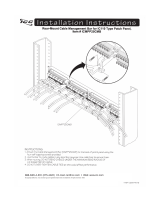
3
CONTENTS
CONTENTS
About This Manual ................................................ 2
CONTENTS ............................................................. 3
INSTALLATION ............................... 5
Chapter 1 Introduction ....................................... 6
1-1. About ColorNavigator .................................. 6
1-2. About ColorNavigator License .................... 6
●
How to Check License Registration ................ 6
1-3. Features ......................................................... 7
1-4. Main Window ................................................. 8
●
About Marks ...................................................10
Chapter 2 Setting Up ........................................ 11
2-1. System Requirements .................................11
2-2. Installing Software .......................................14
●
Mac .................................................................14
●
Windows .........................................................17
2-3. Connecting Monitor with Measurement
Device ............................................................19
2-4. Uninstalling Software ..................................19
●
Mac .................................................................19
●
Windows .........................................................19
BASIC ........................................... 20
Chapter 3 Starting Up and Quitting ................ 21
3-1. Starting Up ColorNavigator ........................21
●
Mac .................................................................21
●
Windows 10 ....................................................21
●
Windows 8.1 ...................................................21
●
Windows 7 ..................................................... 22
3-2. Displaying Software Version ..................... 22
3-3. Quitting ColorNavigator ............................. 23
●
Mac ................................................................ 23
●
Windows ........................................................ 23
Chapter 4 Adjusting Monitor ........................... 24
4-1. Preparing Adjustment ................................ 24
4-2. Adjusting Monitor ....................................... 25
Chapter 5 Creating Adjustment Target .......... 32
Chapter 6 Periodic Adjustment ....................... 46
6-1. Timer ............................................................. 46
6-2. About SelfCalibration / SelfCorrection .... 46
Chapter 7 Validating Adjustment Status
of Monitor ........................................ 47
APPLICATION ............................... 52
Chapter 8 Setting Monitor Validation ............. 53
8-1. Importing the Validation Target ................ 53
8-2. Deleting Validation Target.......................... 55
Chapter 9 Customizing Adjustment Target ... 56
9-1. Exporting and Importing the Adjustment
Target ............................................................ 56
9-2. SettingaProlePolicy ............................... 57
9-3. Setting Destination Folder for ICC
ProleSaving .............................................. 58
9-4. CreatingProleEmulationData ................ 60
9-5. Manual Adjustment ..................................... 62
9-6. Adjusting Light Booth ................................ 66
Chapter 10
Customizing Monitor Adjustment
... 71
10-1. Setting Measurement Device......................71
10-2. Standard Mode calibration ........................ 72
Chapter 11 Creating Film Emulation Data ....... 73
Chapter12 CreatingICCProleofTablet/
Display Device ................................ 74
12-1. CreatingICCProleofTablet/Display
Device to be Emulated.................................75
12-2. SavingICCProle ........................................81
12-3. Exporting and Importing the
Measurement Result ................................... 82
12-4. Creating Average Value from
Measurement Result ................................... 83
12-5. SettingICCProleCreationProcedure ... 84
12-6. Deleting Measurement Result ................... 84
REFERENCE ................................ 85
Chapter 13 Making Use of the Built-in
Calibration Sensor / Built-in
Correction Sensor .......................... 86
13-1. About Built-in Calibration Sensor / Built-
in Correction Sensor .................................. 86
13-2. Correlate with the Reference
Measurement Device .................................. 86
13-3. Setting the SelfCalibration /
SelfCorrection Schedule ............................ 90
●
SelfCalibration ................................................91
●
SelfCorrection ............................................... 92
Chapter 14 Reference ........................................ 93
14-1. Using ColorNavigator in Multiple
Monitor Environment .................................. 93
14-2. Adjusting Monitor with Multiple PCs
Connected .................................................... 94
14-3. Using ColorNavigator Agent ..................... 95
●
Available Functions ....................................... 95
●
Active Icon ..................................................... 95
●
Preventing ColorNavigator to reside ............. 96
●
Changing Adjusted Target ............................. 96




















